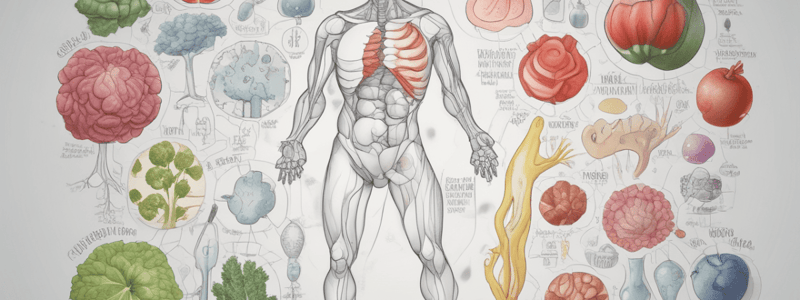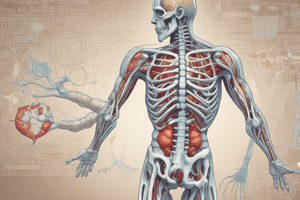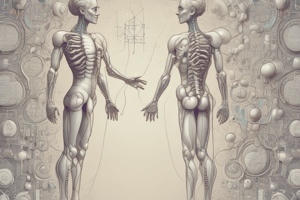Podcast
Questions and Answers
What is the primary function of the skeleton in regulating calcium levels?
What is the primary function of the skeleton in regulating calcium levels?
- To uptake calcium phosphate from interstitium
- To release calcium phosphate into interstitium
- To provide structural support
- To buffer serum levels (correct)
What is the biologically active form of calcium in the body?
What is the biologically active form of calcium in the body?
- Total calcium
- Ionized calcium (correct)
- Calcium phosphate
- Hydroxyapatite
Which hormone is responsible for the acute regulation of calcium levels?
Which hormone is responsible for the acute regulation of calcium levels?
- Parathyroid hormone (correct)
- Calcitriol
- Vitamin D
- 1,25-dihydroxycholecalciferol
What is the primary function of osteoclasts in bone remodeling?
What is the primary function of osteoclasts in bone remodeling?
What is the percentage of total body calcium found in the ECF?
What is the percentage of total body calcium found in the ECF?
What is the hormonally active metabolite of vitamin D?
What is the hormonally active metabolite of vitamin D?
What is the primary function of the skeleton in terms of calcium regulation?
What is the primary function of the skeleton in terms of calcium regulation?
How does vitamin D increase the uptake of Ca2+ from the gut?
How does vitamin D increase the uptake of Ca2+ from the gut?
What is the effect of low serum calcium on PTH synthesis?
What is the effect of low serum calcium on PTH synthesis?
What is the role of osteoclasts in bone remodelling?
What is the role of osteoclasts in bone remodelling?
What is the effect of PTH on osteoblasts?
What is the effect of PTH on osteoblasts?
What is the biologically active form of vitamin D?
What is the biologically active form of vitamin D?
What is the effect of high serum calcium on PTH synthesis?
What is the effect of high serum calcium on PTH synthesis?
What is the role of osteoblasts in bone remodelling?
What is the role of osteoblasts in bone remodelling?
What is the main circulating form of vitamin D?
What is the main circulating form of vitamin D?
What is the effect of PTH on bone reabsorption?
What is the effect of PTH on bone reabsorption?
What is the primary function of 1a-hydroxylase in vitamin D metabolism?
What is the primary function of 1a-hydroxylase in vitamin D metabolism?
What is the effect of elevated PTH on vitamin D metabolism?
What is the effect of elevated PTH on vitamin D metabolism?
What is the primary function of calcitriol in calcium homeostasis?
What is the primary function of calcitriol in calcium homeostasis?
What is the effect of hypocalcaemia on neuromuscular function?
What is the effect of hypocalcaemia on neuromuscular function?
What is the primary function of osteoclasts in bone remodelling?
What is the primary function of osteoclasts in bone remodelling?
What is the effect of chronic hypercalcaemia on the kidney?
What is the effect of chronic hypercalcaemia on the kidney?
What is the primary function of PTH-related peptide (PTHrp) in malignancy?
What is the primary function of PTH-related peptide (PTHrp) in malignancy?
What is the effect of calcitonin on calcium homeostasis?
What is the effect of calcitonin on calcium homeostasis?
Flashcards are hidden until you start studying
Study Notes
Calcium in the Body
- An adult human contains approximately 1000g of calcium, with 99% of it stored in bones as hydroxyapatite crystals.
- The skeleton provides structural support, acts as a major reserve of calcium, helps buffer serum levels, and releases/uptakes calcium phosphate into/from the interstitium.
- Approximately 300-600mg of calcium is exchanged between bone and extracellular fluid (ECF) daily.
Plasma Calcium Levels
- Serum total calcium levels range from 2.2-2.6 mmol/L, with free ionized calcium levels closely regulated to 1.0-1.3 mmol/L.
- The biologically active free ionized calcium is distributed among three interconvertible fractions.
- Only a small fraction (<1%) of the total body calcium is present in ECF.
Regulation of Calcium and Phosphate
- Three hormones are involved in regulating calcium and phosphate levels: parathyroid hormone (PTH), calcitriol, and calcitonin.
- PTH is the main acute regulator of calcium, produced by the parathyroid glands, which are located on the posterior surface of the thyroid gland.
Parathyroid Hormone (PTH)
- PTH has no serum binding protein and is synthesized as a straight chain polypeptide hormone (pro-pre-hormone, 115AA long) that is cleaved to 84AA.
- PTH synthesis is regulated at both transcriptional and post-transcriptional levels, with low serum calcium levels up-regulating gene transcription and high serum calcium levels down-regulating it.
- PTH has a half-life of 4 minutes and is continually synthesized, but little is stored.
Calcium-Sensing Receptor (CaSR) and PTH
- The CaSR controls the release of PTH, which targets the kidney, gut, and bone, and has physiological effects on calcium levels.
Bone Remodeling and Calcium Balance
- The skeleton has two primary functions: providing structural support and maintaining serum calcium concentration, with the latter being the priority.
- Bone deposition involves osteoblasts producing collagen matrix, which is mineralized by hydroxyapatite, while bone reabsorption involves osteoclasts producing an acid microenvironment that dissolves hydroxyapatite.
- Bone is dynamic, with a two-step process of bone remodeling involving bone breakdown and reformation.
Actions of PTH on Bone
- PTH stimulates osteolysis by inducing osteoblastic cells to synthesize and secrete cytokines, which stimulate differentiation and activity in osteoclasts and protect them from apoptosis.
- PTH decreases osteoblast activity, exposing the bony surface to osteoclasts, leading to reabsorption of mineralized bone and release of Pi and Ca2+ into ECF.
Calcitriol (Vitamin D)
- Calcitriol is the hormonally active metabolite of vitamin D, produced from calcidiol in the kidney.
- Vitamin D is formed in the skin upon sunlight exposure, and dietary intake is typically 1000mg/d, with only 30% absorbed through a paracellular uptake.
Calcitriol's Actions on Bone, Gut, and Kidney
- Calcitriol stimulates the transcellular uptake of calcium from the gut, increases bone resorption, and decreases the loss of calcium in the urine.
Feedback Regulation of Serum Calcium
- Elevated calcium levels prevent C-1 hydroxylation, while PTH stimulates C-1 hydroxylation to form calcitriol.
Overview of Calcium Regulation
- Calcium regulation involves a feedback loop between serum calcium levels, PTH, and calcitriol.
Disorders of Calcium Balance
- Hypocalcaemia can lead to hyper-excitability of the neuromuscular junction, muscle spasms, paralysis, and convulsions.
- Chronic hypercalcaemia can cause renal calculi, kidney damage, constipation, dehydration, tiredness, and depression.
- Hypercalcaemia can also cause lethargy, depression, constipation, renal calculi, frequent urination, nausea, and cardiac arrhythmias.
Hypercalcaemia and Malignancy
- Some malignancies can alter calcium homeostasis indirectly via various endocrine factors.
- Hypercalcaemia is commonly seen in breast cancer, squamous cell lung cancer, myeloma, and genito-urinary cancers.
Studying That Suits You
Use AI to generate personalized quizzes and flashcards to suit your learning preferences.




